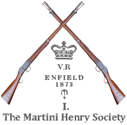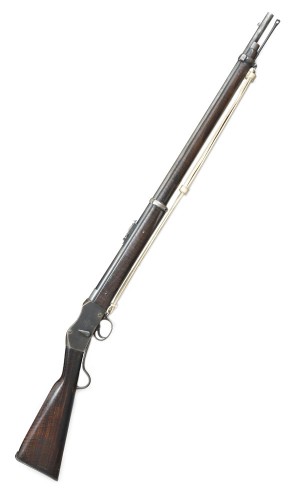Martini Henry Rifle Mk1-Mk II Upgrade
| Calibre | 577/450” |
| Date of Approval | 27 April 1877 |
| Length | 4’1” (L) 4’0” (s) |
| Weight | 8lb 12oz |
26th Jan 1876 a conference at the War office met to discuss the potential upgrades to the MkI Martini Henry, proposed by Supt Close of the Royal Small Factory. Close forwarded a memorandum to the war office on 5th October 1875.
“20 Rifles with the new pattern tumbler, trigger and altered guard gave to following results:
1st Tumbler rest dispensed with
2nd Tumbler rest axis screw dispensed with
3rd Guard encloses trigger so no sand or dust can interfere with the working of the trigger.”
The alterations were approved on the 18th February 1876 by the Secretary of State for war Lord Cranbrook. The sealed pattern new arm was presented on 25 April 1877 and on the 27 April 1877 the MkII arm was accepted for manufacture, List Of Change 3193: Arms, Interchangeable,-Rifle Breech loading, Martini Henry, with Clearing Rod MkII.
The Altertion had the following changes.
1) To remedy the miss-fire faults, the trigger assembly was completely redesigned and a far more robust single part tumbler introduced.
2) A shrouded axis to protect the trigger nose from dirt ingress was installed.
3) The new sized tumbler required a 3/8” x 9/16” slot cutting into the bottom of the breech block to clear the top of the new tumbler
4) The extractor was altered for the new parallel base pattern to give a more robust extraction. **not always carried out**
5) The sight ladder had a deeper notch cut into the cap, It had been complained that the earlier Mk1 pattern shallow “V” notch did not facilitate accurate sighting, in particular at ranges between 100-400 yards with the ladder laid flat on the sight bed.
6) New 1876 pattern cleaning rod
7) Breech Block browned (blued)
8) Muzzle countersunk head filed level.
A program of conversion began to be implemented of the 450,000 Mk1. Rifles made. Contrary to popular belief, the upgrade could not be carried out in the field by regimental artificers. The Small arms store at Weedon had begun an immediate alteration to rifles in the store, with 125,771 being converted by March 1878 with components made at Enfield, those in service took longer, by 20.1.1878 only 18,000 Mk1 rifles in the hands of the troops had been converted to home and Ireland. By 20.1.79 it was reported over 300,000 Mk1's remained unconverted but work was expected to have been completed by March 1880.
Converting those 450,000 Mk1 rifles produced by the factory and the two trade manufacturers to the new classification cost 2s per rifle. In the process of upgrade the actions were removed and the following actions undertaken. The tumbler, tumbler rest and transverse screw were dispensed with. A reamer was employed to cut away the original trigger axis in the trigger assembly. The trigger assembly was de-greased the area and a hooded trigger axis was then brazed into place. The assembly was then re-blued. (Brass will not accept blue, today, a thin brass joint can often be seen where brazed joint has been effected). The breech block was stripped of pin, spring and lock nut, and a slot approx. 3/8” x 9/16” was milled into the base to clear the new tumbler. The block was then browned (blued) in solution. Externally the sight ladder and sliders were altered, and the muzzle crown was filed to remove the countersunk head. It is not unusual to find Mk1/2. Upgraded rifles, dated 1872-1874 showing the evidence of being a Mk1. second pattern rifle, with the crescent shape infill to the axis pin and safety slot adjacent to the trigger, then upgraded to Mk1. third pattern, ultimately upgraded to a MkII. During the process of upgrade the component parts became interchanged, as a result the serial numbers were no longer desired to be matching to the block and lever, as a consequence, from the MkII. rifle only the Barrel, Action and Sight ladder were to be subsequently marked with serial numbers.
The most obvious alteration, on completion of the conversion was a second roman “1” stamped onto the action to denote its upgrade, and the stock roundel was stamped with a second “1”.
Conversions carried out
Royal Small Arms factory
Enfield Weedon Depot Northamptonshire
The Tower: Bagot St Birmingham.









